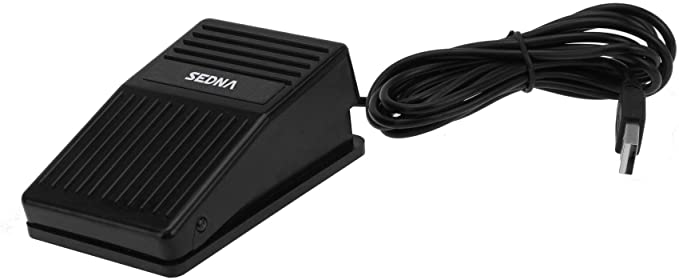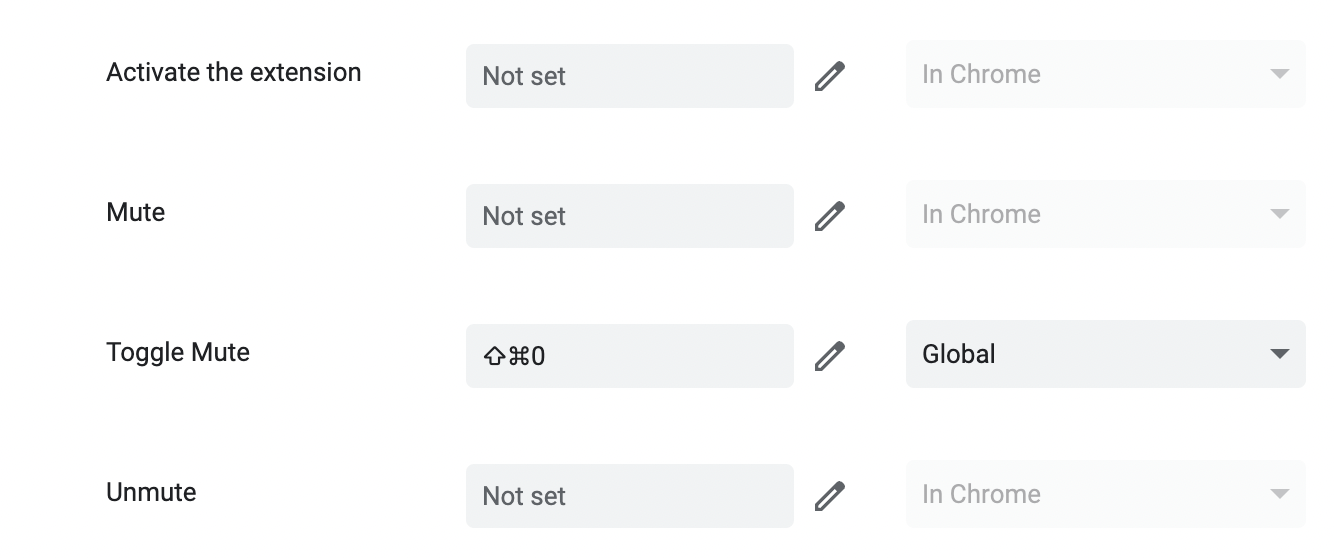Foot Pedal For Mute
I use a novel control scheme to mute and unmute my microphone during meetings—a foot pedal. The benefits for meetings, I feel are obvious, but you know, for SEO let's list them anyway:
- you can keep typing while you meet
- you can keep gesticulating wildly and still interject easily
- you don't need to find the browser tab that has the meeting in it in order to contribute
- you can idly play with it and think you're a rockstar 🧑🎤
I use Google Meet for my meetings, but this guide probably works for other providers, too. Read on! 👇
What You Need
I bought this footpedal (Amazon) and recommend it for its simplicity. You can also find it on Newegg, or a bunch of other places, and like all random USB devices, it is sold under a variety of brand names. (Please @-me on Twitter if you find it somewhere really cheap.)

At the same time, here's a style I tried out which you should not get. The low profile style here means that pressing it tends to "bounce", and trigger several times in rapid succession. 😡
Also, you probably need… a computer. And Chrome, because this needs an extension to work (maybe the extension will work in another browser too).
How to set it up
The footpedal is basically a USB keyboard that can type one thing, so the first steps are used to make it type something that we can pick up globally.
Build the footswitch library
Go and grab footswitch so you can change what that thing is.
It has its own instructions for macOS, but I always have trouble with them. I set it up like this (you'll need Homebrew and macOS developer tools set up first):
$ git clone https://github.com/rgerganov/footswitch.git
$ cd footswitch/
# need hidapi to talk to USB devices
$ brew install hidapi
# need to fix lib/include paths just for this build
$ export LIBRARY_PATH="$LIBRARY_PATH:$(brew --prefix)/lib"
$ export C_INCLUDE_PATH="$C_INCLUDE_PATH:$(brew --prefix)/include/hidapi"
# now build!
$ gcc common.c debug.c footswitch.c -lhidapi -o footswitch
If you're non-technical, ask a friend to do this for you. You only need to do this once when you're first configuring the pedal.
Configure it to type something
Now, the important step: we can query the pedal and tell it to type something. For me, I have it type "Left Shift + Left Windows + 0"—a fairly unique combination. (The Windows key is just the ⌘ on Macs.)
You can see what your footpedal is currently set to by passing -r:
$ ./footswitch -r
[switch 1]: unconfigured
[switch 2]: l_shift+l_win+0
[switch 3]: unconfigured
And update it like this: (-m adds modifiers, and -k types a key)
$ ./footswitch -m l_shift -m l_win -k 0
The same chipset is also used for USB foot pedals with 1-3 switches, but the default for pedals that only have a single switch is switch 2️⃣, so footswitch will write to it by default.
Listen to that key in Google Meet
Now, install a plugin like Meet Mute. Open the "Extensions" tab of Chrome, and then click on the hamburger and open "Keyboard shortcuts". (You can also go directly to "chrome://extensions/shortcuts" if you'd like to type it in.)

Now, configure "Toggle Mute" to be your new shortcut—you can even focus the input box and use your footpedal to type it in! Be sure you set it to "Global", not "In Chrome"—the point is that your footpedal should work everywhere. (On macOS you might need to allow Chrome more permissions at this point.)
Superflous notes
-
You'll need to do this per-profile if say, you have a personal and work profile like me
-
Zoom, and other providers, might also have global key shortcuts and their own extensions. (Zoom is also the worst because it makes you install its app, even though its website is perfectly fine.)
That's it!
Enjoy hands-free meetings! Here's a dumb picture of me toggling my keys while gesticulating wildly. Consider it a prize for getting this far.
Bye! 👣